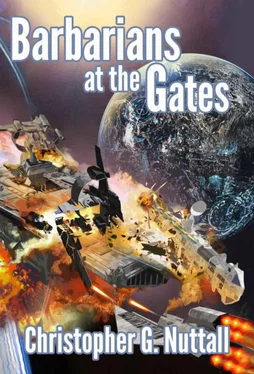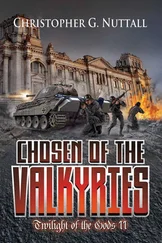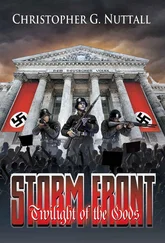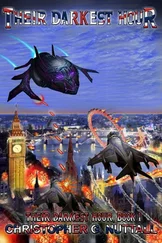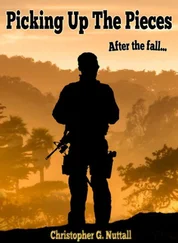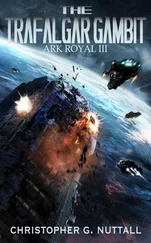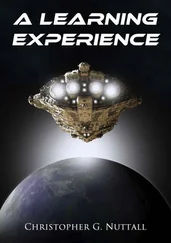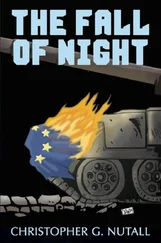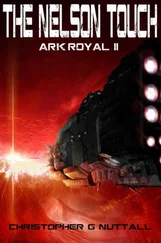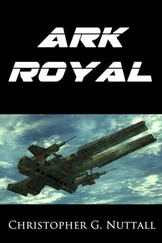Why?
* * *
Admiral Justinian’s techs hadn’t been able to make a new breakthrough in force field technology. What they had managed to do was combine two very old concepts—matter-antimatter power generation and shaped force fields—and install the result in the smartest missiles the human race had been able to devise. The problem with antimatter warheads was that it was impossible to shape the blast, ensuring that most of the energy was radiated out into space. But the combined missiles, ungainly though they were, were able to direct most of the blast into a single lance of unimaginable power. The force fields lasted little longer than a handful of seconds, but it was enough.
And, by combining the schematics of Enterprise with the homing missiles, they knew precisely where to aim.
* * *
“Incoming! Brace for…”
Enterprise’s very hull seemed to scream as deadly lances of energy speared deep into her vitals. Roman clung onto his console for dear life as the entire ship shuddered violently. The lighting flickered out for a second, just before a shockwave sent someone flying across the secondary bridge and into a bulkhead. The console flared with red light, warning that it was now the tactical console for the entire ship, and Roman was suddenly her tactical officer.
“She’s dead,” Sultana said in alarm. “Roman…”
Roman turned to see Commander Duggan. Her body was crumpled against the bulkhead, her head hanging at an unnatural angle. It didn’t take a doctor to know that there was nothing that could be done for her, not now. He keyed the internal communications system, trying to contact sickbay anyway, but the entire system seemed to have crashed.
Roman stared up at the status display in alarm. Judging from the reports, whatever the hell they’d been hit with had penetrated the hull only ten meters above the secondary bridge. It took him a moment to realize why—and then he almost had a fit of the giggles. Commander Duggan had told him that the yard dogs, working on the ship, had lowered the secondary bridge down two decks.
It had saved their lives.
“Case Omega,” the internal monitoring system announced. “Case Omega is now in effect.”
He sobered quickly. Case Omega meant that the captain was dead…and the chain of command was broken. If the flag bridge had been hit, the admiral and his staff were probably dead as well. His duty was to report to whoever was senior, once the internal monitoring system determined who had both seniority and a pulse. They couldn’t all be dead…
“Case Omega completed,” the intercom announced. “Lieutenant Garibaldi is in command.”
Roman stared at the console. He was nineteenth in the chain of command. He couldn’t be in command. One of the senior lieutenants had to have survived, or the engineer or the major…but none of them was apparently in the chain of command.
“Captain,” Sultana said formally.
Roman flinched. She was his junior by bare hours.
“We have more missiles incoming,” she told him. “What are your orders?”
And the crushing weight of command fell on Roman’s shoulders.
Fiction is full of examples of crippled starships somehow making it back home, but in reality it is rare for a cripple to escape. When a ship is crippled, but not destroyed, it generally means that the enemy intends to take her as a prize.
-
An Irreverent Guide to the Federation , 4000 A.D.
Jefferson System, 4092
“Admiral Drake, we have multiple incoming contacts on attack vector,” the sensor officer reported. Her well-trained voice revealed no panic. “Designating contact details now.”
Only a few hours into the system and everything is going to hell, Marius thought bitterly. But at least the penny has finally dropped. We finally know where Justinian is.
“Show me,” Marius ordered.
He swallowed a curse as the holographic display lit up with red icons. His first inclination was to dismiss what he was seeing, for it looked like something out of a first-year tactical planning assignment at the Academy. Entire fleets of superdreadnaughts and carriers were bearing down on his fleet, lighting up their drives in a manner that ensured they would be detected. It looked as if the entire Federation Navy had rallied to fight beside Admiral Justinian and his allies. His second, more coldly rational thought was that it was a trick. The sensors were picking up over ten thousand superdreadnaughts, an impossible figure. If Admiral Justinian had had such a force, he would have blown through Earth’s defenses and Home Fleet, winning the war in a single blow.
“Designating group one as Bogey One,” the sensor officer said, attempting to give shape and form to the oncoming threat. “Designating group two as Bogey Two…”
Marius nodded to himself as the display continued to sharpen. The sight before him suggested that Justinian was deploying decoys, using ECM to fool his long-range sensors into having flights of fancy. But the rogue admiral would know that Marius wouldn’t be fooled—and he’d positioned his decoys so that the Retribution Force would have plenty of time to get over their panic, if Marius had been inclined to panic. Most of those ships weren’t real, he knew; the only question was which ones were genuine starships. Picking the wrong course could lead to a close-range engagement against a superior force.
“Admiral, Bogey Four is launching starfighters and gunboats,” the sensor officer reported. “The smaller craft will reach the Asimov Point in seven minutes—mark.”
New red icons flared into life on the display. Bogey Four was behind the Asimov Point and piling on the acceleration, attempting to reach the Asimov Point before Marius and his fleet could double back and escape. It showed a degree of tactical coordination and flexibility that should have been impossible. All promising officers were taught to hold to the KISS Principle—Keep It Simple, Stupid—and Justinian, it seemed, had tried to launch as complicated a feint as possible.
Or they might transit the point themselves , Marius thought coldly. The third prong of the Retribution Force was still on the other side of the Asimov Point, awaiting orders to transit into the Jefferson System. They weren’t escorted by anything larger than a battlecruiser, which meant that a single superdreadnaught squadron could slaughter the transports and commandeer the yachts before they could scatter and run. If the supplies were lost, the Retribution Force would be unable to reload its missile tubes once the engagement was over—assuming a victorious engagement. Admiral Justinian might just have pulled off the strangest victory in the history of space warfare.
“Communications, prepare a mass launch of courier drones,” Marius ordered. A mass launch would fire upwards of a thousand courier drones towards the Asimov Point. The enemy wouldn’t be able to intercept all of them, unless they’d manage to develop something completely new. But the enemy starfighters would be on the Asimov Point before the courier drones got there. He shook his head. It was the best warning he could give the remainder of the Retribution Force. “Stand by to record a message.”
“Drones ready, sir,” the communications officer said. “Standard emergency protocols engaged.”
“Record,” Marius ordered, keying his console. “Admiral Hawser, this is Admiral Drake. The Retribution Fleet has been ambushed; do not attempt to transit the Asimov Point into Jefferson. Cloak your ships and withdraw from the Asimov Point; I say again, cloak your ships and withdraw from the Asimov Point. If you do not hear from us in twelve hours, or if enemy ships start transiting the Asimov Point in force, declare yourself in command and head back to base—the long way around. I am attaching an up-to-date copy of our sensor logs with this message. Good luck.”
Читать дальше
